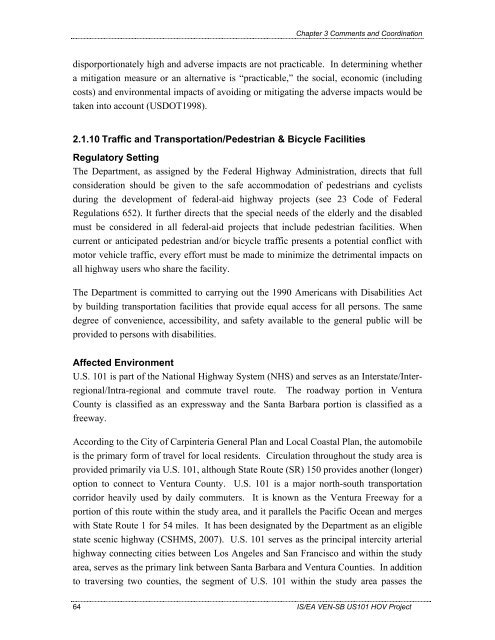Chapter 1 - Caltrans - State of California
Chapter 1 - Caltrans - State of California
Chapter 1 - Caltrans - State of California
You also want an ePaper? Increase the reach of your titles
YUMPU automatically turns print PDFs into web optimized ePapers that Google loves.
<strong>Chapter</strong> 3 Comments and Coordination<br />
disporportionately high and adverse impacts are not practicable. In determining whether<br />
a mitigation measure or an alternative is “practicable,” the social, economic (including<br />
costs) and environmental impacts <strong>of</strong> avoiding or mitigating the adverse impacts would be<br />
taken into account (USDOT1998).<br />
2.1.10 Traffic and Transportation/Pedestrian & Bicycle Facilities<br />
Regulatory Setting<br />
The Department, as assigned by the Federal Highway Administration, directs that full<br />
consideration should be given to the safe accommodation <strong>of</strong> pedestrians and cyclists<br />
during the development <strong>of</strong> federal-aid highway projects (see 23 Code <strong>of</strong> Federal<br />
Regulations 652). It further directs that the special needs <strong>of</strong> the elderly and the disabled<br />
must be considered in all federal-aid projects that include pedestrian facilities. When<br />
current or anticipated pedestrian and/or bicycle traffic presents a potential conflict with<br />
motor vehicle traffic, every effort must be made to minimize the detrimental impacts on<br />
all highway users who share the facility.<br />
The Department is committed to carrying out the 1990 Americans with Disabilities Act<br />
by building transportation facilities that provide equal access for all persons. The same<br />
degree <strong>of</strong> convenience, accessibility, and safety available to the general public will be<br />
provided to persons with disabilities.<br />
Affected Environment<br />
U.S. 101 is part <strong>of</strong> the National Highway System (NHS) and serves as an Interstate/Interregional/Intra-regional<br />
and commute travel route. The roadway portion in Ventura<br />
County is classified as an expressway and the Santa Barbara portion is classified as a<br />
freeway.<br />
According to the City <strong>of</strong> Carpinteria General Plan and Local Coastal Plan, the automobile<br />
is the primary form <strong>of</strong> travel for local residents. Circulation throughout the study area is<br />
provided primarily via U.S. 101, although <strong>State</strong> Route (SR) 150 provides another (longer)<br />
option to connect to Ventura County. U.S. 101 is a major north-south transportation<br />
corridor heavily used by daily commuters. It is known as the Ventura Freeway for a<br />
portion <strong>of</strong> this route within the study area, and it parallels the Pacific Ocean and merges<br />
with <strong>State</strong> Route 1 for 54 miles. It has been designated by the Department as an eligible<br />
state scenic highway (CSHMS, 2007). U.S. 101 serves as the principal intercity arterial<br />
highway connecting cities between Los Angeles and San Francisco and within the study<br />
area, serves as the primary link between Santa Barbara and Ventura Counties. In addition<br />
to traversing two counties, the segment <strong>of</strong> U.S. 101 within the study area passes the<br />
64 IS/EA VEN-SB US101 HOV Project

















